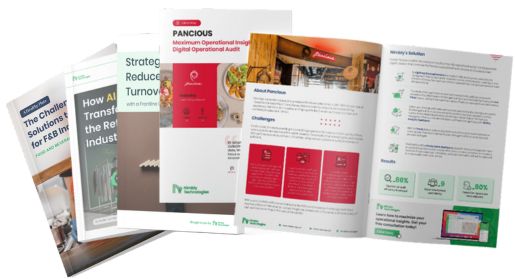

In the fast-paced and competitive world of dining, a restaurant's menu is more than just a list of dishes—it's a crucial tool for attracting and retaining customers. Whether you're a seasoned pro or new to the restaurant scene, optimizing your menu is essential for standing out and thriving in the industry. In this comprehensive guide, we'll delve into the ins and outs of crafting a winning menu that keeps diners coming back for more, all while keeping things simple and easy to understand.
Before diving into the specifics of menu improvement, it's essential to understand why menu updates are crucial for your restaurant's success. Updating your menu regularly offers several benefits, including:
Now that we've established the importance of updating your restaurant menu let's delve into the steps you can take to enhance your menu and drive success.
Begin by conducting a thorough analysis of your current menu. Identify top-selling items, underperforming dishes, and customer favorites. Use sales data, customer feedback, and industry trends to inform your analysis and identify areas for improvement.
Example: You analyze sales data and discover that while your pasta dishes are popular year-round, your seafood specials receive mixed reviews and lower sales during certain months. Customer feedback indicates a desire for more diverse seafood options and lighter fare during the summer months.
Also read: 7 Digital Transformation Trends in Retail and Food & Beverage Industry
Your menu should reflect your restaurant's unique concept and brand identity. Consider your target audience, culinary style, and ambiance when crafting your menu. Ensure that your menu items align with your restaurant's theme and values to create a cohesive dining experience for your customers.
Example: Your restaurant specializes in farm-to-table cuisine, emphasizing locally sourced ingredients and sustainable practices. As you craft your menu, you highlight regional flavors and seasonal produce, aligning with your restaurant's commitment to supporting local farmers and promoting environmental stewardship.
Incorporating seasonal ingredients and culinary trends into your menu can keep your offerings fresh and exciting. Explore seasonal produce, local specialties, and emerging food trends to inspire new menu creations. Highlighting seasonal specials and limited-time offerings can create a sense of urgency and drive customer interest.
Example: Inspired by the growing popularity of plant-based eating, you introduce a seasonal menu featuring innovative vegan dishes made with locally sourced ingredients. By tapping into the trend towards plant-based dining, you attract health-conscious diners and appeal to a broader audience seeking sustainable and ethically sourced options.
A well-balanced menu offers a diverse selection of dishes to cater to different tastes and dietary preferences. Ensure that your menu includes a variety of options, including vegetarian, vegan, gluten-free, and protein-rich dishes. Strive for balance in flavors, textures, and portion sizes to create a harmonious dining experience for your customers.
Example: Recognizing the diverse dietary preferences of your customer base, you expand your menu to include a range of options, from hearty meat dishes to lighter vegetarian fare. By offering a well-balanced selection of dishes, you cater to the needs of all patrons, ensuring an inclusive and satisfying dining experience for everyone.
Also read: Maintaining Food Consistency: Best Practices for Foodservice Operators
Carefully consider pricing strategies to maximize profitability while remaining competitive in the market. Analyze food costs, portion sizes, and menu item popularity to determine optimal pricing. Incorporate high-margin dishes and seasonal specials to drive revenue and profitability.
Example: You analyze the food costs and profit margins of each menu item and identify opportunities to increase profitability without sacrificing quality. By adjusting portion sizes, sourcing ingredients strategically, and incorporating high-margin specials, you optimize pricing to enhance profitability while maintaining competitive pricing in the market.
Also read: Increase Restaurant Reviews and Profit with Issue Tracking App
The presentation of your menu plays a crucial role in shaping the dining experience. Invest in high-quality menu design, photography, and descriptions to showcase your dishes effectively. Consider using visuals, such as mouthwatering food photography, to entice customers and stimulate their appetites.
Example: You invest in professional menu design and photography to elevate the visual appeal of your menu. High-quality images of your signature dishes and enticing descriptions showcase the culinary excellence of your offerings, enticing diners and setting the stage for an exceptional dining experience.
Engage with your customers to gather feedback on your menu offerings. Encourage diners to provide feedback through in-person interactions, online surveys, and social media channels. Use customer insights to identify areas for improvement and refine your menu based on customer preferences.
Example: You actively seek feedback from diners through in-person interactions, online surveys, and social media channels. Based on customer input, you tweak menu items, adjust portion sizes, and introduce new specials to address customer preferences and enhance overall satisfaction.
Learn more about how Voice of Customer platform can help you enhance your customer feedback journey.
Harness the power of technology to streamline menu management and analysis. Utilize digital menu platforms, inventory management software, and analytics tools to track menu performance, monitor inventory levels, and make data-driven decisions. Platforms like Nimbly offer digital checklists and admin dashboards to optimize menu management and improve operational efficiency.
Example: You implement Nimbly's digital menu platform and inventory management software to streamline menu management and analysis. By utilizing digital checklists and admin dashboards, you gain valuable insights into menu performance, track inventory levels, and make data-driven decisions to optimize operations and drive business growth.
Also read: Approved Storage and Inventory Control Best Practices for F&B
Elevating your restaurant menu requires careful planning, creativity, and attention to detail. By following the steps outlined in this guide, you can create a menu that delights customers, maximizes profitability, and sets your restaurant apart in a competitive market. With a strategic approach to menu enhancement and the right tools at your disposal, you can unlock the full potential of your restaurant and drive long-term success.

Crafting a compelling and enticing restaurant menu requires careful planning and strategic execution to ensure that your customers embrace the changes with enthusiasm. Consider these tips to guide you through the menu update process:
By following these best practices and leveraging innovative tools like Nimbly, you can elevate your restaurant menu to new heights, delighting customers and driving business growth.
